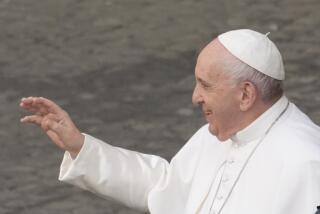Vatican II’s Upheaval Still Is Felt in Catholicism
- Share via
When he convened a gathering of 2,500 Catholic bishops and other church leaders from 135 countries in 1962, Pope John XXIII said it was time to “open the windows” of the oldest of the Christian churches.
Many said later that John did more than let in some fresh air--he let in a hurricane that overturned many of the practices and beliefs of the Roman Catholic Church.
This from the unlikeliest of revolutionaries: a pope dismissed as a “caretaker” when he was elected as a compromise candidate in 1958 at age 76.
The council that became known as Vatican II began modestly--gaining only secondary attention in many newspapers, edged out by stories of growing tension between the United States and Cuba and an ominous buildup of Russian military strength.
Still, the three-year gathering ended up shaking the Catholic Church to its theological foundation in a way unseen since the challenge of Martin Luther in 1517.
“Vatican II brought the church from the 16th century into the 20th century,” said Father Thomas P. Rausch, professor of theological studies at Loyola Marymount University. “It provided the church with a chance for self-examination and to turn its face to the world and ask: ‘How can we best serve you?’ ”
The very breadth of the agenda was without precedent.
Under the watchful eye of John and his successor Pope Paul VI, the prelates debated the role of the church in society, the proper relationship between the priesthood and the laity, and the responsibility of the church to help establish social justice.
“Vatican II was unique among the councils of the church because it was convoked neither to condemn a heresy nor to define a dogma,” wrote Vatican II spokesman Edward Heston.
Nine decrees were passed, with vote tallies made public, a sizable step toward democratization. One of the most striking changes involved affirmation of the “dignity of the baptized,” a phrase meant to emphasize that the church exists to serve its parishioners, not the other way around.
The liturgy would be spoken in the vernacular, not just Latin. Priests were to face their congregations. Laypeople could participate in the distribution of Communion. In some parishes, altar girls were permitted.
Other changes were slower and aimed more at changing ancient prejudices--always something easier said than done.
For the first time, the church hierarchy expressly condemned anti-Semitism and called for greater cooperation with other faiths. Priests were advised that Jews were no longer to be blamed for the death of Christ. Even non-Christian religions were to be considered holy and “seeds of the Word.”
In managerial terms, Vatican II was a move toward decentralization, collegiality and greater empowerment.
Bishops gained greater freedom from Rome--no longer was the pope seen as a kind of monarch. Priests, in turn, were to share authority with parish councils of lay persons. The days when a Catholic was meant only to “pray, pay and obey,” as some church critics put it, were to be banished.
*
Within 20 years of Vatican II, more than three-quarters of Catholic parishes in America were said to have some form of lay councils or other shared governance--a development that once would have been unthinkable in a tradition-bound church.
Church sociologists have suggested that Vatican II helped the American branch of the church adapt to demographic changes as ethnic immigrant groups that have been Catholic strongholds became more affluent, better educated and less willing to accept the paternalistic leadership of priests.
Although hailed in many quarters, Vatican II has been blamed for traumatizing some in the church.
Church attendance plunged. Some Catholics complained that the liturgy had been watered down and stripped of mystery. Priests and nuns left the church in record numbers. Many felt uncomfortable with their reduced roles in the “new” church, others felt liberated by the idea that they could serve God in ways other than being part of a religious order.
Vatican II spurred debates that continue to this today: about the role of women in the church, about whether Catholicism should embrace revolution for the oppressed, and about priestly celibacy and the importance of sexual mores in Catholic teaching.
A frequent criticism of the current pontiff, John Paul II, is that he has sought to reassert the centralized control from Rome that Vatican II had tried to dismantle.
“A lot of us have unfilled expectations of Vatican II,” said Msgr. Joe Carroll, who directs nationally acclaimed programs for the poor in San Diego and Las Vegas. “The conservatives fought Vatican II, the liberals took it too far, and I’m not sure the church ever put its full heart into it.”
More to Read
Sign up for Essential California
The most important California stories and recommendations in your inbox every morning.
You may occasionally receive promotional content from the Los Angeles Times.













